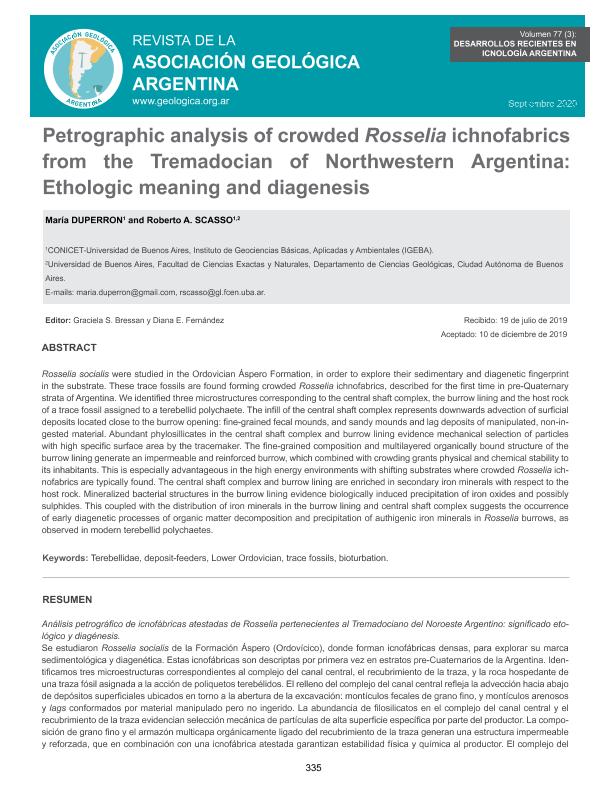Artículo
Se estudiaron Rosselia socialis de la Formación Áspero (Ordovícico), donde forman icnofábricas densas, para explorar su marca sedimentológica y diagenética. Estas icnofábricas son descriptas por primera vez en estratos pre-Cuaternarios de la Argentina. Identificamos tres microestructuras correspondientes al complejo del canal central, el recubrimiento de la traza, y la roca hospedante de una traza fósil asignada a la acción de poliquetos terebélidos. El relleno del complejo del canal central refleja la advección hacia abajo de depósitos superficiales ubicados en torno a la abertura de la excavación: montículos fecales de grano fino, y montículos arenosos y lags conformados por material manipulado pero no ingerido. La abundancia de filosilicatos en el complejo del canal central y el recubrimiento de la traza evidencian selección mecánica de partículas de alta superficie específica por parte del productor. La composición de grano fino y el armazón multicapa orgánicamente ligado del recubrimiento de la traza generan una estructura impermeable y reforzada, que en combinación con una icnofábrica atestada garantizan estabilidad física y química al productor. El complejo del canal central y recubrimiento de la traza están enriquecidos en minerales secundarios de hierro respecto a la roca. Las estructuras bacterianas mineralizadas del recubrimiento evidencian precipitación biológicamente inducida de óxidos de hierro y posiblemente de sulfuros. Esto, en conjunto con el enriquecimiento en minerales de hierro, sugiere descomposición de la materia orgánica durante la diagénesis temprana, con la consiguiente precipitación de minerales autigénicos de hierro en las excavaciones de Rosselia, tal como se observa en las de poliquetos terebélidos modernos. Rosselia socialis were studied in the Ordovician Áspero Formation, in order to explore their sedimentary and diagenetic fingerprint in the substrate. These trace fossils are found forming crowded Rosselia ichnofabrics, described for the first time in pre-Quaternary strata of Argentina. We identified three microstructures corresponding to the central shaft complex, the burrow lining and the host rock of a trace fossil assigned to a terebellid polychaete. The infill of the central shaft complex represents downwards advection of surficial deposits located close to the burrow opening: fine-grained fecal mounds, and sandy mounds and lag deposits of manipulated, non-ingested material. Abundant phylosillicates in the central shaft complex and burrow lining evidence mechanical selection of particles with high specific surface area by the tracemaker. The fine-grained composition and multilayered organically bound structure of the burrow lining generate an impermeable and reinforced burrow, which combined with crowding grants physical and chemical stability to its inhabitants. This is especially advantageous in the high energy environments with shifting substrates where crowded Rosselia ichnofabrics are typically found. The central shaft complex and burrow lining are enriched in secondary iron minerals with respect to the host rock. Mineralized bacterial structures in the burrow lining evidence biologically induced precipitation of iron oxides and possibly sulphides. This coupled with the distribution of iron minerals in the burrow lining and central shaft complex suggests the occurrence of early diagenetic processes of organic matter decomposition and precipitation of authigenic iron minerals in Rosselia burrows, as observed in modern terebellid polychaetes.
Petrographic analysis of crowded Rosselia ichnofabrics from the Tremadocian of Northwestern Argentina: Ethologic meaning and diagenesis
Título:
Análisis petrográfico de icnofábricas atestadas de Rosselia pertenecientes al Tremadociano del Noroeste Argentino: significado etológico y diagénesis
Fecha de publicación:
09/2020
Editorial:
Asociación Geológica Argentina
Revista:
Revista de la Asociación Geológica Argentina
ISSN:
0004-4822
e-ISSN:
1851-8249
Idioma:
Inglés
Tipo de recurso:
Artículo publicado
Clasificación temática:
Resumen
Palabras clave:
Terebellidae
,
Deposit-feeders
,
Lower Ordovician
,
Trace fossils
Archivos asociados
Licencia
Identificadores
Colecciones
Articulos(IGEBA)
Articulos de INSTITUTO DE GEOCIENCIAS BASICAS, APLICADAS Y AMBIENTALES DE BS. AS
Articulos de INSTITUTO DE GEOCIENCIAS BASICAS, APLICADAS Y AMBIENTALES DE BS. AS
Citación
Duperron, Maria; Scasso, Roberto Adrian; Petrographic analysis of crowded Rosselia ichnofabrics from the Tremadocian of Northwestern Argentina: Ethologic meaning and diagenesis; Asociación Geológica Argentina; Revista de la Asociación Geológica Argentina; 77; 3; 9-2020; 335-352
Compartir




